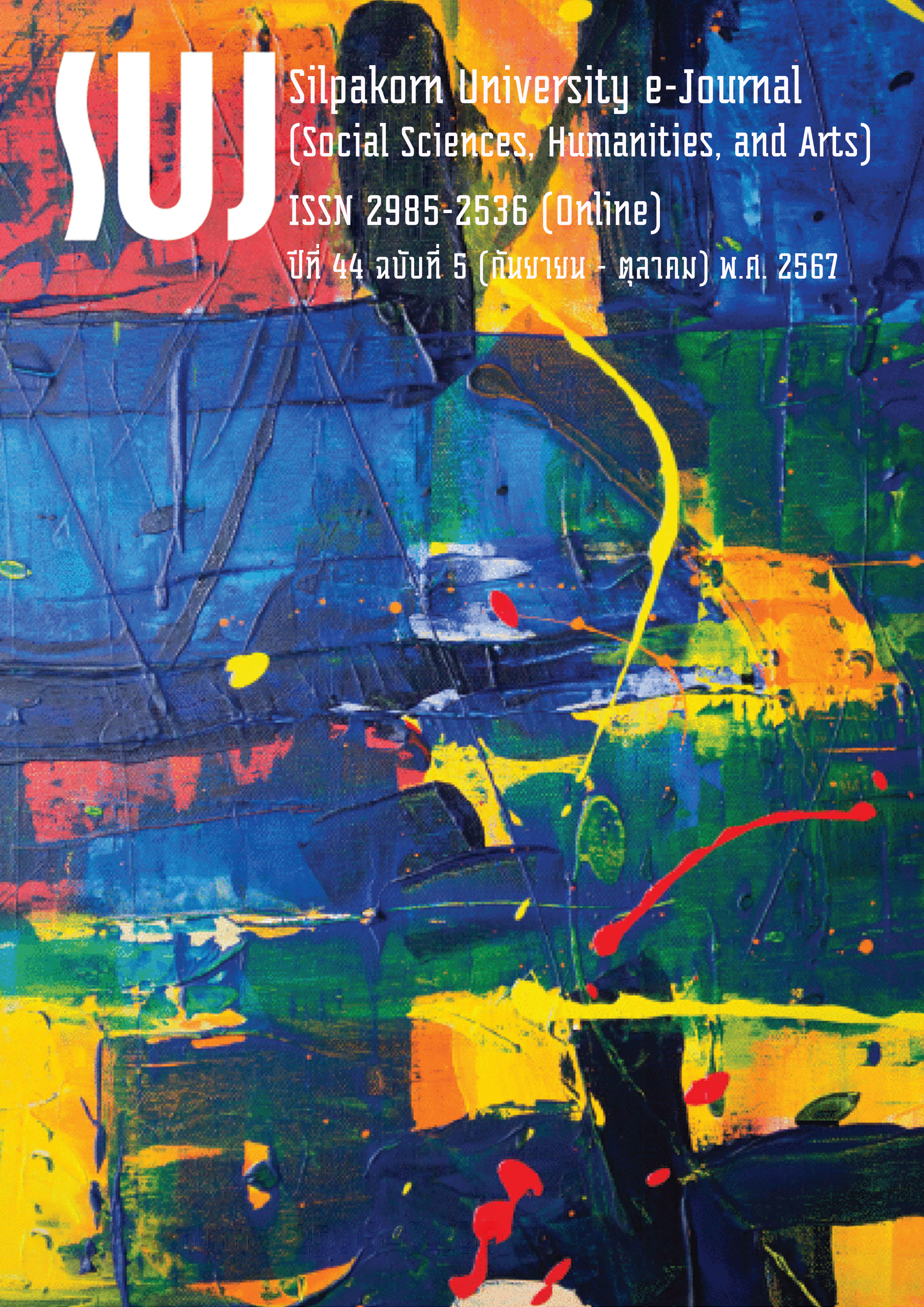การเติบโตของเมืองนครปฐมผ่านบทบาทของชาวจีน (The growth of Nakhon Pathom City through the role of the Chinese)
Main Article Content
Abstract
บทความวิจัยนี้มีวัตถุประสงค์เพื่อศึกษาการเข้ามามีบทบาทของชาวจีนที่ส่งผลต่อการเจริญเติบโตของเมืองนครปฐมโดยใช้วิธีการศึกษาแบบวิเคราะห์ผ่านเอกสารชั้นต้นและเอกสารชั้นรอง ด้วยหลักระเบียบวิธีวิจัยทางประวัติศาสตร์ ผลการศึกษา พบว่า ชุมชนเมืองนครปฐมเติบโตไปพร้อมกับชุมชนชาวจีนที่เข้ามาตั้งถิ่นฐานในพื้นที่ ผ่านการเข้ามาเป็นแรงงานรับจ้างในการบูรณะองค์พระปฐมเจดีย์และรับจ้างขุดคลองเจดีย์บูชา ตั้งแต่ พ.ศ. 2396 เมื่องานทั้งสองเสร็จสิ้นใน พ.ศ. 2405 แรงงานชาวจีนเหล่านี้ก็ปักหลักอยู่อาศัยในเขตเมืองนครปฐม โดยเฉพาะบริเวณริมคลองเจดีย์บูชา ซึ่งเป็นคลองเชื่อมต่อไปยังกรุงเทพฯ และด้วยความสะดวกในการติดต่อกับเมืองหลวงนี้เอง ที่เอื้ออำนวยต่อการเกิดเส้นทางการค้า ส่งผลให้เกิดครัวเรือนของพ่อค้าชาวจีนจำนวนมากในเมืองนครปฐม และเมื่อนานเข้าก็ขยายตัวเป็นชุมชนการค้าขนาดใหญ่ในตัวเมือง ต่อมาเมื่อมีการขยายเส้นทางรถไฟเข้ามาถึงตัวเมืองนครปฐมใน พ.ศ. 2447 ก็ยิ่งทำให้เมืองเติบโตมากยิ่งขึ้น พร้อมกันนั้นรัฐบาลได้มีคำสั่งให้ย้ายที่ว่าการมณฑล ที่แต่เดิมตั้งอยู่บริเวณริมแม่น้ำนครชัยศรี มาตั้งอยู่ที่ใหม่บริเวณองค์พระปฐมเจดีย์ใน พ.ศ. 2447 และท้ายที่สุด นครปฐมจึงได้รับการยกระดับอย่างเป็นทางการให้เป็นเมืองเอกของมณฑลนครชัยศรี ในปี พ.ศ. 2456 และได้รับการพัฒนาขึ้นเป็นจังหวัดนครปฐมในเวลาต่อมา ทั้งนี้ ตลอดช่วงเวลาแห่งการเติบโตของเมืองนครปฐมนั้น ชาวจีนมีบทบาทสำคัญอย่างยิ่ง จนอาจกล่าวได้ว่า ถ้าไม่มีชาวจีน เมืองนครปฐมก็มิอาจเติบโตขึ้นได้อย่างที่เป็นอยู่ทุกวันนี้ โดยผู้วิจัยคาดหวังว่าบทความนี้จะช่วยส่งเสริมให้เข้าใจถึงการเติบโตของเมืองนครปฐมและกระตุ้นให้ผู้อ่านเกิดความสนใจศึกษาเรื่องราวของเมืองนครปฐมมากยิ่งขึ้น
This research article aims to study the role of the Chinese people in the growth of Nakhon Pathom City by employing an analytical approach through primary and secondary documents, utilizing historical research methodology. The findings reveal that the Nakhon Pathom community grew alongside the Chinese community that settled in the area, beginning with their involvement as laborers in the restoration of the Phra Pathom Chedi and in excavating the Chedi Bucha Canal since 1853. Once the projects were completed in 1862, the Chinese laborers established their residences in the Nakhon Pathom urban area, particularly along the banks of Chedi Bucha Canal, which connects to Bangkok. The ease of communication with the capital facilitated the emergence of trade routes, resulting in a significant number of Chinese merchant households in Nakhon Pathom. Over time, this developed into a large trading community within the city. Subsequently, when the railway was expanded to reach Nakhon Pathom City in 1904, the city experienced even greater growth. In conjunction with this, the government ordered the relocation of the provincial administration, which was originally situated along the Nakhon Chai Si River, to a new location near the Phra Pathom Chedi in 1904. Ultimately, Nakhon Pathom was officially elevated to become the capital of Nakhon Chai Si Province in 1913 and later developed into Nakhon Pathom Province. Throughout the period of Nakhon Pathom’s growth, the Chinese played a crucial role, to the extent that it can be said that without the Chinese, Nakhon Pathom would not have developed as it has today. The researcher hopes that this article will promote an understanding of the growth of Nakhon Pathom City and stimulate readers’ interest in further studying the history of Nakhon Pathom.
Downloads
Article Details

This work is licensed under a Creative Commons Attribution-NonCommercial-NoDerivatives 4.0 International License.
References
Burutphat, Khachatphai. (1974). Chinese People in Thailand (ชาวจีนในประเทศไทย). Bangkok: Praepittaya.
Chantavanich, Supang, Lertpanichkul, Suparat, Burusrattanapan, Wanwipa, M.L., Pathmanand, Ukrist, Visawanan, Sawai, Mahattanobol, Worasak, Tiarakkitsakul, Pornpan, Xu, Shaolin, Zhang, Yanqiu, Deng, Shuizheng, Luo, Xiaojing, & Lin, Feng. (1996). The Teochiu Chinese in Thailand and in the Native Land at Chaoshan: The Second Period, Xantou Port 1860-1949 (BE. 2403-2492) (ชาวจีนแต้จิ๋วในประเทศไทยและในภูมิลำเนาเดิมที่เฉาซันสมัยที่สอง ท่าเรือซ่านโถว ค.ศ. 1860-1949 (พ.ศ. 2403-2492)). Bangkok: Chinese Studies Center, Institute of Asian Studies Chulalongkorn University.
Damrong Rajanubhab, Prince. (1975). Memory (ความทรงจำ). Bangkok: Sermvit Bannakhan Publishing.
Hennequin, L., & Chansaeng, K. (Eds.). (2009). Nakhon Pathom Suksa in French Documents, Including Translated Articles (นครปฐมศึกษาในเอกสารฝรั่งเศส รวมบทความแปล). Nakhon Pathom: Centre de Documentation et de Recherches d’Etudes Franco-thaïes (CEDREET), Faculty of Arts, Silpakorn University.
Kanokmongkol, Nitaya. (1991). Traces of Communities in the Nakhon Chai Si River Basin Before the 24th Buddhist Century (ร่องรอยชุมชนบริเวณลุ่มแม่น้ำนครชัยศรีก่อนพุทธศตวรรษที่ 24). Bachelor’s degree, Silpakorn University, Bangkok, Thailand.
Kongthavthong, Monthon. (1984). Rice and Sugar Economy in the Thachin Flood Plain, 1855-1910 (เศรษฐกิจข้าวและน้ำตาลทรายในลุ่มแม่น้ำท่าจีน พ.ศ. 2398-2453). Master’s dissertation, Silpakorn University, Nakhon Pathom, Thailand.
Lertpanichkul, Suparat. (2001). Find a Living to Trade, to Sell: Thai Economy in Early Rattanakosin (หาอยู่หากิน เพื่อค้าเพื่อขาย : เศรษฐกิจไทยรัตนโกสินทร์ตอนต้น). Bangkok: Matichon.
Lisheng, Duan, Promputr, Tapanee, Raisooksiri, Boonying, & Noipituk, Watcharee. (1997). Role of Chinese Thais in Economic Development in Western Region : Case Study of Nakornpathom Province (Research report) (บทบาทของชาวไทยเชื้อสายจีนต่อการพัฒนาเศรษฐกิจในภูมิภาคตะวันตก : ศึกษากรณีจังหวัดนครปฐม) (รายงานการวิจัย). Bangkok: Huachiew Chalermprakiet University.
Pornsiripongse, Saowapa, Usuparat, Pornthip, Bausuang, Apinya, Kamnunwat, Duanporn, & Sasiwongsaroj, Kwanjit. (2003). Nakon Chaisri River Plain Communities: An Investigation into Their Ways of Life (วิถีชุมชนลุ่มน้ำนครชัยศรี). Bangkok: Thailand Science Research and Innovation.
Sakkriangkrai, Sirilak. (2008). The Origin of the Capitalist Class in Thailand (1855-1910) (ต้นกำเนิดของชนชั้นนายทุนในประเทศไทย (พ.ศ. 2398-2453)) (3rd ed.). Bangkok: Sangsan Book.
Skinner, G. W. (Writer), & Kasetsiri, C. (Ed.). (2021). Chinese Society in Thailand: An Analytical History (สังคมจีนในประเทศไทย: ประวัติศาสตร์เชิงวิเคราะห์), 3rd ed. (P. Chatphonrak, C. Ampaiphan, P. Sirisuk, M.R., P. Kanchanathithi, P. Boonyasiri, & S. Tawichaprasit, Trans.). Bangkok: Matichon.
Teewakul, Bunnak. (1983). Chedi Bucha Canal and Its Economic and Social Effects on Communities in Nakhon Pathom Municipality (Research report) (คลองเจดีย์บูชากับผลทางเศรษฐกิจและสังคมที่มีต่อชุมชนในเขตเทศบาลเมืองนครปฐม) (รายงานการวิจัย). Nakhon Pathom: Silpakorn University.
Tungkeunkunt, Kornphanat. (2022). Modern Chinese History (ประวัติศาสตร์จีนสมัยใหม่). Bangkok: Sermvit Bannakhan Publishing.


